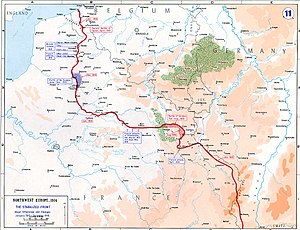First Battle of the Argonne
| Second Battle of Champagne | |||||||
|---|---|---|---|---|---|---|---|
| Part of the Western Front of World War I | |||||||
 Western front 1915–1916 |
|||||||
|
|||||||
| Belligerents | |||||||
|
|
|
||||||
| Commanders and leaders | |||||||
|
|
|
||||||
| Strength | |||||||
|
Fourth Army Second Army 450,000 men in 27 divisions |
3rd Army 220,000 men in 19 divisions |
||||||
| Casualties and losses | |||||||
| 145,000 | 72,500 (25,000 taken prisoner) |
||||||
The Second Battle of Champagne in World War I was a French offensive against the invading German army.
On 25 September 1915, twenty divisions of the Second Army and Fourth Army of Groupe d'armées du Centre (GAC, Central Army Group), attacked at 9:15 a.m., with each division on a 1,500–2,000 yards (1,400–1,800 m) front. A second line of seven divisions followed, with one infantry division and six cavalry divisions in reserve. Six German divisions held the line opposite, in a front position and a reserve position the R-Stellung (Rückstellung, Reserve Position) further back. French artillery observers benefitted from good weather but on the night of 24/25 September, heavy rain began and fell until midday.
The German front position was broken in four places and two of the penetrations reached as far as the R-Stellung, where uncut barbed wire prevented the French from advancing further. The French took 14,000 prisoners and several guns but French casualties were also high; the Germans had anticipated the French attack, having been able to watch the French preparations from their high ground and outposts. The main defensive effort was made at the R-Stellung, behind which the bulk of the German field artillery had been withdrawn. A supporting attack by the French 3rd Army on the Aisne took no ground.
Joffre allotted two reserve divisions to the GAC and ordered the Groupe d'armées de l'Est (GAE, Eastern Army Group) to send all 75 mm field gun ammunition, except for 500 rounds per gun, to the Second and Fourth armies. On 26 September, the French attacked again, closed up to the R-Stellung on a 7.5-mile (12.1 km) front and gained a foothold in one place. Another 2,000 German troops were captured but attacks against the R-Stellung from 27–29 September, broke through on 28 September. A German counter-attack next day recaptured the ground, most of which was on a reverse slope, which had deprived the French artillery of ground observation; Joffre suspended the offensive until more ammunition could be supplied and ordered that the captured ground be consolidated and cavalry units be withdrawn. Smaller French attacks against German salients continued from 30 September – 5 October.
...
Wikipedia
